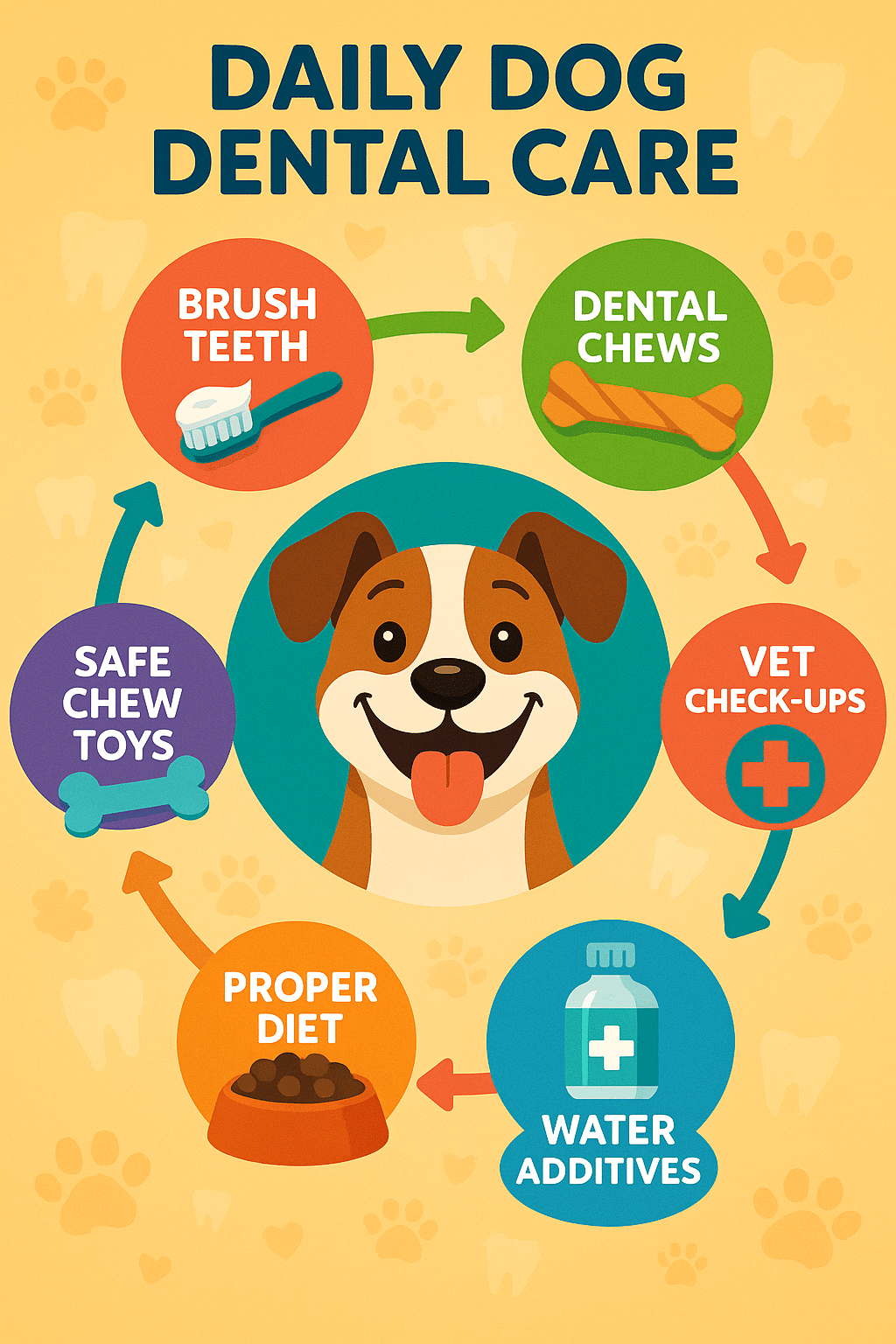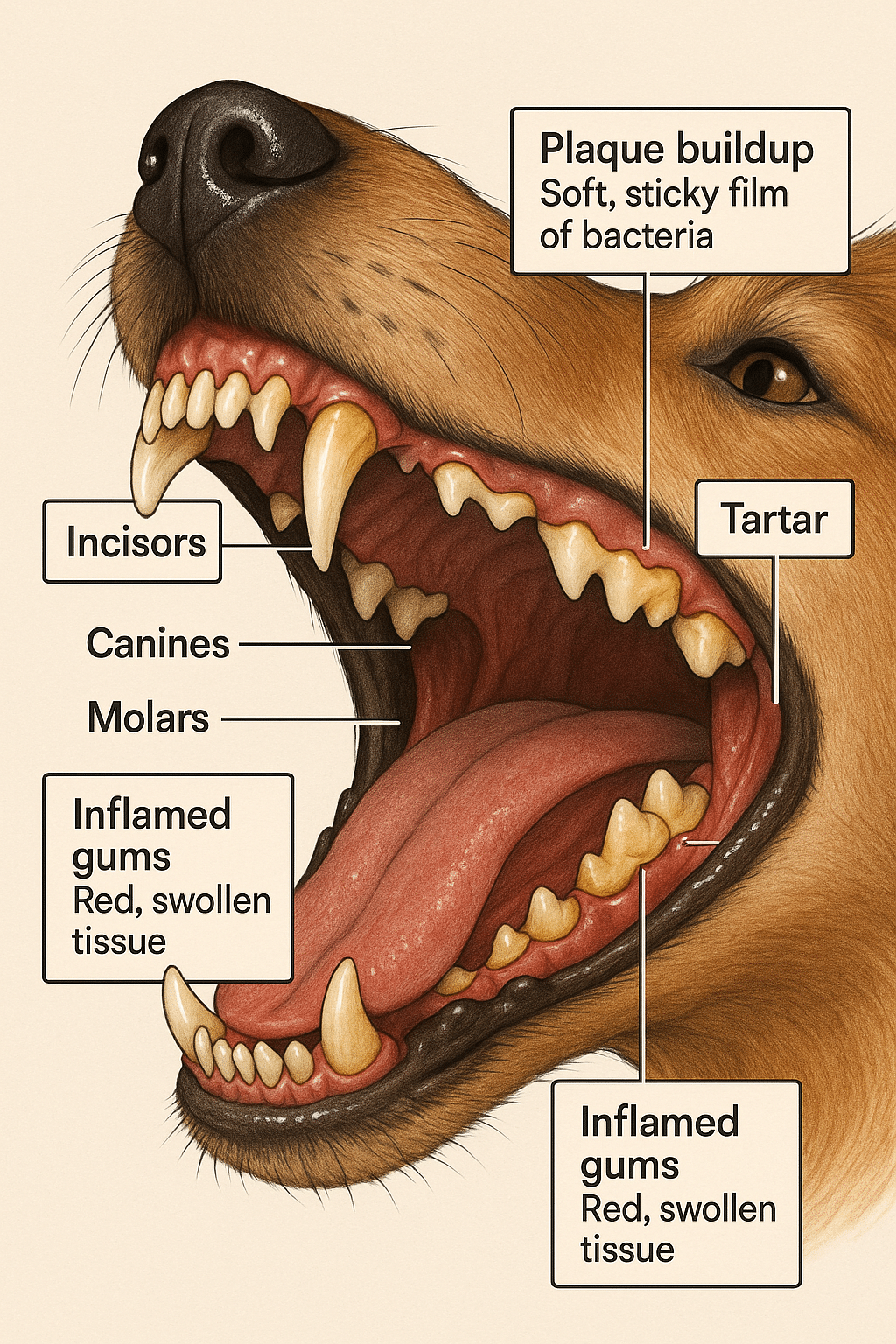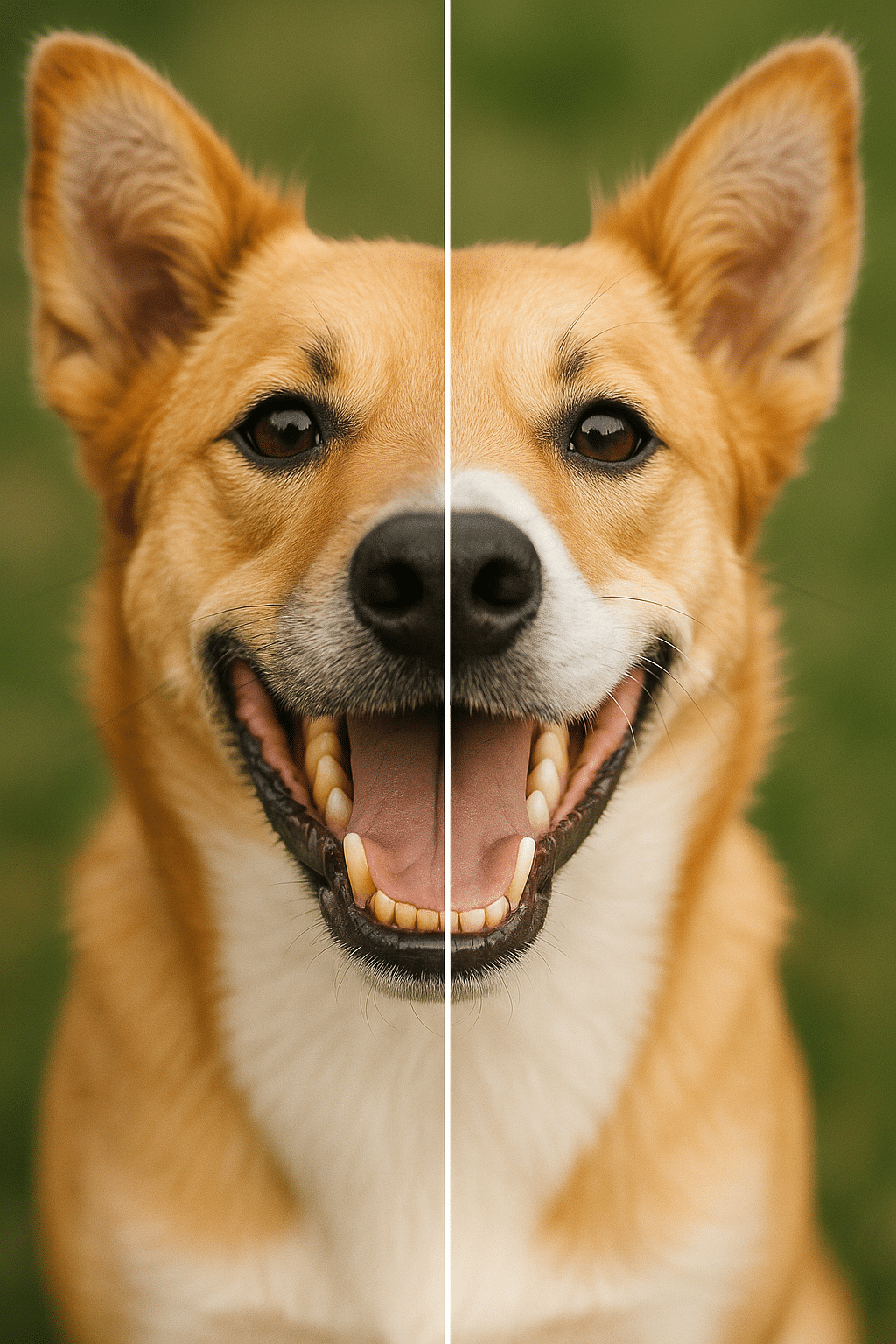When we talk about keeping our furry friends happy and healthy, it’s easy to overlook one crucial area: their oral health. Dog dental care is often underestimated, yet it plays a pivotal role in your pet’s overall wellbeing. Just like people, dogs can suffer from plaque buildup, tartar, gum disease, and even tooth loss if proper care isn’t provided. Regular attention to your dog’s teeth not only helps prevent painful conditions but also supports their longevity and quality of life.
In this article, I’ll take you through six essential dog dental care tips. We’ll discuss why dog dental care matters, how to develop a daily routine, and which products and professional procedures can make a real difference. Whether you’re a new pet owner or someone with years of experience, these insights are tailored to help you understand and apply the best strategies for your dog’s oral health. From brushing techniques and choosing safe toothpaste to recognizing signs of dental disease and addressing breed-specific challenges, you’ll find everything here. Let’s dig into the world of canine oral health and ensure your dog’s smile stays bright and healthy for years to come!
Understanding Canine Oral Health: Why Dog Dental Care Matters

Dental care for dogs is more than just preventing bad breath. It’s a critical component of their overall health. Many pet owners are unaware that periodontal disease affects nearly 80% of dogs over the age of three, making it one of the most common health problems in canines. Periodontal disease, the inflammation and infection of the tissues surrounding the teeth, can lead to pain, tooth loss, and more severe systemic problems like kidney, liver, and heart disease.
The Impact of Periodontal Disease on Overall Dog Wellbeing
Periodontal disease begins with plaque buildup — a sticky film full of bacteria that accumulates on teeth. Without regular cleaning, plaque hardens into tartar, which irritates the gums and causes inflammation known as gingivitis. Left untreated, this inflammation damages the tissues holding teeth in place.
I’ve seen firsthand how dogs with untreated periodontal disease develop painful mouth sores and difficulty eating. In some cases, the infection can enter the bloodstream, affecting vital organs — a risk that’s too high to ignore. The good news is that with regular dog dental care, you can prevent these complications before they ever start.
Common Signs of Dental Disease in Dogs: What Every Pet Owner Should Know
Spotting dental issues early can save your dog from discomfort and costly veterinary bills. Look out for:
- Bad breath (halitosis) that persists despite good hygiene at home.
- Yellow or brown buildup on teeth (plaque and tartar).
- Red, swollen, or bleeding gums.
- Difficulty eating or dropping food.
- Pawing or rubbing at the mouth.
- Excessive drooling.
- Loose or missing teeth.
- Behavioral changes like irritability or withdrawn behavior.
If you notice any of these signs, it’s time to consult your veterinarian. Early intervention often means simpler treatments and a smoother recovery.
Developing a Daily Dog Dental Care Routine for Pet Owners and Families

Creating a daily dog dental care routine might sound intimidating, but it’s absolutely doable and rewarding. The key is consistency, patience, and using pet-safe products tailored to your dog’s needs.
How to Brush Dog Teeth Properly at Home: Step-by-Step Training for Puppies and Adults
Brushing your dog’s teeth is the cornerstone of maintaining oral health. Here’s how to get started:
-
Gather Supplies: Use a dog toothbrush — these often have soft bristles and a shape suited for canine mouths. Avoid human toothbrushes. Select a safe dog toothpaste, ideally flavored to appeal to dogs but free from harmful chemicals and xylitol (which is toxic to dogs). Virbac C.E.T. Enzymatic Toothpaste is an excellent option for sensitive gums.
-
Introduce Tooth Brushing Slowly: For puppies, start by gently rubbing their gums with your finger to get them used to oral handling. Then introduce the toothbrush gradually, letting them sniff and lick the toothpaste.
-
Position Your Dog Comfortably: Have your dog sit next to you or on your lap. Keep sessions short at first to avoid stress.
-
Brush in Circular Motions: Focus on the outside of the upper and lower teeth, where plaque usually accumulates. Brush each side in gentle circles for about 30 seconds.
-
Reward Your Dog: Use praise or a small treat immediately afterward. This creates positive associations with the routine.
-
Establish a Schedule: Daily brushing is ideal, but aim for at least 3-4 times a week to reduce plaque buildup significantly.
The trick is to be patient and persistent. Many dogs grow to enjoy their brushing sessions, especially when coupled with positive reinforcement.
Safe Dog Toothpaste Options for Sensitive Gums and Introducing Tooth Brushing to Puppies
Not all dog toothpaste is created equal—choose products that are free of foaming agents and harsh chemicals. Special options for sensitive gums include enzymatic formulations that gently break down plaque and soothe irritation.
Puppy dental training should start as early as 8 weeks of age. Use low-flavor, gentle formulations and avoid pushing too hard early on. Gradually extend brushing time over weeks and celebrate every small success to build lifelong dental habits.
Choosing the Best Dog Dental Chews and Toys for Plaque and Tartar Control
Alongside brushing, dental chews and toys provide an enjoyable way to reduce plaque and tartar naturally through mechanical abrasion. Here are some outstanding choices:
-
Greenies Original Dental Chews: Approved by the Veterinary Oral Health Council (VOHC), these chews help reduce plaque and freshen breath. They’re formulated with fiber and natural ingredients safe for dogs.
-
Nylabone Dental Chew Toys: Tough, textured toys encourage chewing, which scrapes off plaque. Ideal for aggressive chewers.
-
KONG Dental Toys: Designed with ridges and nubs that help clean teeth and gums during play. Also allows inserting treats, adding mental stimulation.
When selecting chews or toys, consider your dog’s size, chewing strength, and dental needs. Always supervise to prevent choking or excessive wear.
Evaluating Dog Dental Sprays vs Dental Powders: Effectiveness and Usage Tips
Some owners find sprays or powders easier than brushing for at-home dental care. Here’s a quick rundown:
-
Dental Sprays: These are liquid formulas that you spray directly into your dog’s mouth, targeting bacteria and freshening breath. Products like TropiClean Fresh Breath Oral Care Spray contain natural enzymes for plaque control. Sprays are user-friendly but usually complement, not replace, brushing.
-
Dental Powders: Powders can be added to food or applied directly on teeth. They contain ingredients like chlorhexidine or antimicrobial herbs that reduce bacterial growth. One example is Petsmile Professional Dog Dental Powder.
Both methods aid plaque control, but for best results, incorporate brushing and chews with sprays or powders. Pay attention to your dog’s response and consult your vet if unsure.
Professional Dog Dental Care: Procedures and Frequency Explained

No matter how diligent your home care is, professional dental cleanings are essential to maintain deep oral health.
What to Expect During a Veterinary Dental Cleaning: Anesthesia and Oral Exam Procedures
Professional dog teeth cleaning involves several careful steps:
-
Pre-Anesthetic Exam: The vet assesses overall health via physical exams and blood tests. Anesthesia is generally required for thorough cleaning to keep your dog safe and still.
-
Dental X-rays: These are crucial to spot hidden issues like root infections or bone loss unseen to the naked eye.
-
Scaling and Polishing: The vet or technician removes plaque and tartar using ultrasonic scalers, both above and below the gumline. Polishing smooths teeth surfaces, preventing rapid plaque buildup.
-
Treatment & Follow-up: If issues like cavities or periodontal pockets are found, treatment plans including extractions or antibiotics are discussed.
Post-cleaning, your dog may feel tender but will enjoy fresher breath and improved oral function.
How Often Should Dogs Have Professional Dental Cleanings? Guidance for Different Breeds
The answer varies depending on breed, age, and oral health history:
-
Small Breeds and Toy Dogs: These breeds, like Chihuahuas and Dachshunds, are prone to tartar and require cleanings every 6 to 12 months.
-
Medium to Large Breeds: Typically benefit from professional cleanings every 12 to 18 months.
-
Senior Dogs: As gums weaken, increased frequency may be necessary.
Your vet can recommend a schedule based on oral exams and risk factors. Regular home care extends the time between professional visits, saving stress and money down the road.
The Role of Veterinary Dental X-rays in Diagnosing Hidden Dental Issues
Veterinary dental X-rays are indispensable tools. They reveal hidden problems such as:
- Abscesses and infections at tooth roots.
- Bone loss from advanced periodontal disease.
- Fractured or resorbed teeth.
- Impacted or retained baby teeth.
These conditions often cause pain but might not show visible signs until severe. X-rays allow early diagnosis and treatment, preventing unnecessary suffering.
Breed-Specific Dental Challenges and Tailored Dental Care Strategies
Understanding breed-related dental risks helps customize your dog’s care.
Dog Breeds Prone to Dental Problems and Preventive Measures
Small and brachycephalic breeds tend to experience more dental issues:
-
Breeds like Yorkshire Terriers, Poodles, and Pomeranians often develop early tartar buildup due to crowded teeth.
-
Bulldogs, Pugs, and Shih Tzus have flattened faces that promote gum inflammation and difficulty cleaning.
Preventive care includes daily brushing, frequent dental checks, and breed-specific chews or diets recommended by your vet.
Dental Diets for Dogs: Benefits and Selecting the Right Food
Dental diets contain kibble designed to mechanically clean teeth as your dog chews or include ingredients that reduce plaque and tartar. For example, Hill’s Prescription Diet t/d is widely recognized and recommended by vets.
These diets are great adjuncts to brushing and can support gum health. However, they should not replace daily care routines but rather complement them.
Home Remedies for Bad Dog Breath and Maintaining Fresh Breath Naturally
Bad breath often signals oral health issues but can be improved through natural means at home:
-
Add fresh parsley or mint leaves to your dog’s diet. These herbs have deodorizing properties.
-
Provide raw carrots or apples for chewing, which help scrub teeth.
-
Ensure your dog drinks plenty of water to flush bacteria.
-
Avoid feeding high-sugar or processed treats that exacerbate bacterial growth.
Remember, while remedies freshen breath temporarily, underlying causes like dental disease require veterinary assessment.
Affordable Dog Dental Care Tips for Families: Balancing Cost and Quality Care
Keeping your dog’s teeth healthy doesn’t need to break the bank. Here are wallet-friendly tips:
-
Invest in a soft-bristled dog toothbrush and enzymatic toothpaste. These usually cost under $20 and last months.
-
Use homemade dental treats made from safe ingredients such as peanut butter and sweet potato.
-
Incorporate daily brushing as much as possible; regular at-home care reduces professional cleaning costs.
-
Select dental chews carefully—many affordable brands offer VOHC-approved products.
-
Schedule annual vet dental exams to catch issues early and avoid expensive emergencies.
Integrating Preventive Veterinary Care with At-Home Practices for Optimal Oral Health
The best dental care happens when home and veterinary efforts combine.
Monitoring Gum Health: Identifying Gingivitis and Canine Tooth Loss Causes Early
Check your dog’s gums monthly. Healthy gums are pink and firm. Watch for:
- Redness or swelling.
- Bleeding during brushing.
- Loose teeth or receding gums.
Early gingivitis is reversible with brushing and chews, but advanced disease requires vet intervention.
The Connection Between Dental Health and Overall Longevity in Dogs
Studies show dogs with good oral health tend to live longer and enjoy better quality of life. Dental disease can trigger chronic pain and systemic infections, shortening lifespan. Caring for your dog’s teeth is an investment in years of joyful companionship.
Final Thoughts: Building a Lifelong Partnership for Your Dog’s Dental Wellness
Proper dog dental care is a journey worth taking. It involves understanding your pet’s unique needs, committing to daily hygiene routines, choosing the right products, and collaborating with your veterinarian for professional care. Remember, your efforts directly impact your dog’s comfort, happiness, and long-term health.
By adopting these six essential dog dental care tips, you’re not only preventing pain and costly treatments but also creating a bond built on trust and wellbeing. Start small—maybe with choice #1, brushing your dog’s teeth properly at home—and watch your furry friend’s smile glow brighter with every passing day. Your dog relies on you for holistic care, and this means embracing dental health with optimism and determination.
Now, why not pick up a dog toothbrush and that safe toothpaste today? Your companion’s beautiful smile is waiting!
FAQs
Q1: How to brush dog teeth properly at home without stressing my dog?
A1: Introduce brushing gradually by letting your dog sniff toothpaste and toothbrush first. Start with short sessions and gentle circular motions on the outer teeth, rewarding with praise or treats. Consistency and patience are key.
Q2: What are the best dog dental chews for plaque control and safe for sensitive gums?
A2: Greenies Original Dental Chews and certain Nylabone products offer relief from plaque while being gentle. Select VOHC-approved chews and monitor your dog’s chewing habits to avoid choking risks.
Q3: How often should dogs have professional dental cleanings?
A3: Frequency depends on breed and health but typically every 6-18 months. Small breeds often require more frequent cleanings, while larger dogs might need less frequent professional care supplemented by home brushing.
Q4: Are dental sprays or powders more effective for dog dental care?
A4: Both have benefits; sprays are easy to apply, and powders can be added to food or applied topically. Neither replaces brushing but can complement a daily dog dental care routine for enhanced plaque control.
Q5: Can certain dog breeds be more prone to dental problems?
A5: Yes, small breeds like Chihuahuas and brachycephalic breeds like Bulldogs are more vulnerable due to tooth crowding and facial structure. Tailored dental care, including specialized diets and frequent brushing, helps manage risks.
Quick Takeaways
- Regular brushing with dog-safe toothpaste is essential for effective dog dental care.
- Dental chews and toys complement brushing by reducing plaque mechanically.
- Professional cleanings involve anesthesia and dental X-rays to address unseen issues.
- Breed-specific challenges require customized dental routines and diets.
- Home remedies can help freshen breath but don’t replace veterinary care.
- Monitoring gum health monthly catches problems early, preventing tooth loss.
- Combining daily care with preventive vet visits promotes longer, healthier lives for dogs.


